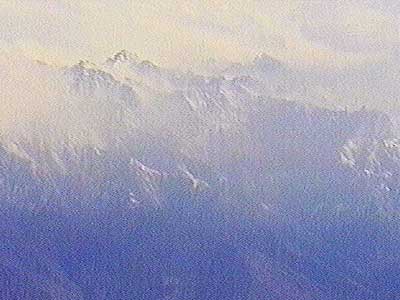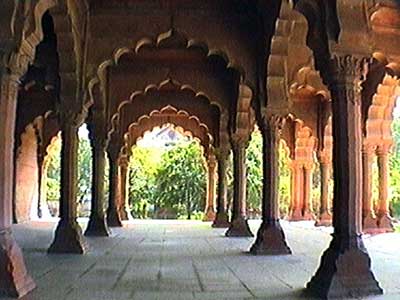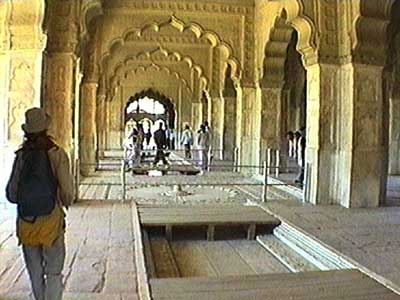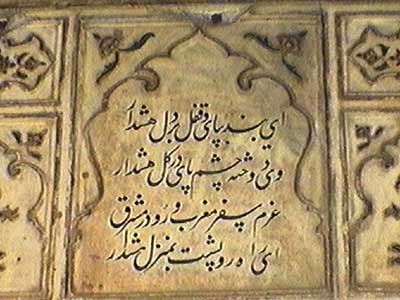DELHI (Day 20)
We had to get up at 5 am to catch our plane to Delhi. We went down to the hotel lobby but no one was there except one of the bellboys who was sleeping on the couch. We had pre-arranged (and prepaid) for a taxi to the airport, but it was not to be seen outside. We waited and waited but eventually had no choice to wake the boy and ask for help. He ran around a bit, inside and out, and after a while came back and told us our taxi was there.
We grabbed our luggage and followed him a ways out to the street. The cab driver wasn't very friendly and had even brought a sleeping kid with him in the front seat. Either way, we were eventually on our way. Everywhere in the street, people were cleaning up the trash. The trip was relatively short and by 6 am, we were at the airport. There were police at the main door and we had to show our valid plane tickets to get in. In order to get on the plane, we had to walk cross the tarmac to the plane itself. The balcony of airport building was absolutely packed with spectators. I began to be concerned about the number of accidents this country sees!

Our only good(ish) view of the Himalayas... from the airplane!
An hour later we landed in Delhi. Unfortunately before we could do some site-seeing, we had to go reconfirm our tickets. We found an office in the airport but they told us they couldn't help us and that we would have to call the main office ourselves. But we refused to give up and finally one of them called for us. We were informed that our flight was going to delayed (departing at 3:30 am instead of 2 am, but we would still have to check in at 11:30 pm.
Our next task was to find a place to store our luggage. We wandered even more and asked many airport people. Eventually we were told to find the small building outside of the visitor's lounge, however they didn't mention that we first had to walk across a large parking lot and a bus loading area. We only had two small duffel bags but they wanted us to pay for two bags even though they would both easily fit together in one compartment. So Ron tied the bags together and suddenly they only counted as one bag.
By noon, we were on on bus headed into town. There was a lot of traffic... but this was a city clearly not accustomed to orderly traffic rules. The word "relax" was written across the red light of the stoplight, and a sign had the with the words "always drive in lane" above a picture of cars lined up nicely in their proper lanes.
We needed just a little bit of money for the day, but it proved to be very difficult in finding a bank that would change money... and if it did, it had to be a minimum of $100. We were finally told to try Thomas Cook. This was a very bizarre building. The entire upper floor was decorated as a beach! The yellow and blue carpet was designed to look like sand and water, including a surf line. The desks were in the shape of a wave (with a computer embedded in it), a sand castle or a bamboo bar. The chairs were shaped like half of a row boat. Fake palm trees lined the way and the ceiling was curved and covered with photos of divers swimming overhead. We changed our money and went back outside to reality.
Our original plan was to walk to the Red Fort, but after wandering aimlessly for so long and getting nowhere, not to mention the large waste of time with the banks, we decided to rent a tuktuk. There were tuktuks offering tours but we just wanted to get to the fort. We found one guy who agreed to take us there for 20 rupees but then tried to change the price to 35 once we were loaded up and under way. So the moment he slowed down, I jumped out and started to walk off. He suddenly he agreed to the other price again and we reluctantly (and stupidly) climbed back in. Sure, he dropped us off at the fort... but at the service personnel gate. Of course, hordes of tuktuk drivers mobbed us offering to drive us to the main gate a bit further down. We decided to walk the 5 minute stretch ourselves.
The Lal Qila (or Red Fort) was a 1-mile long fortress built by the Great Mughal Shah Jahan between 1638 and 1648 to defend the new capital and his family. The walls are 100 feet tall and a moat moat filled with water from the nearby Yamuna river once circled it as well. The fort was not nearly as ornate or well-kept as others. Much of the inlay and paint was chipped and the carvings had dulled. There were only mere remnants of lovely mirrored ceilings, and the many intricate waterways (which all united at a large marble lotus-shaped centerpiece) were all dry. But it was easy to imagine how spectacular it must have been.




The center canals were once filled with water.

The Diwan I Khas (Hall of Private Audiences)
Leaving the fort was a sheer nightmare due to all the tuktuk drivers and vendors. They would absolutely not leave us alone. There was also an unbelievable amount of traffic in parking area and even more once we reached the main street. Eventually we made it to a busy shopping area,where we had some lunch and bought a few gifts, souvenirs and spices.
In one store, we met a man of the Sikh religion and decided to ask him a few questions about the temple located just across the street. So he brought us there and showed us what to do in order to enter. First we had to turn in our shoes (for which we received a square silver token). We walked around to the front of the temple and across the cold wet pavement, while being careful to avoid the folks vigorously scrubbing the ground in front of the temple on their hands and knees. We encountered a guard with a rather substantial knife at his side and he gave us a gold thing to wear on our heads. We then followed a green carpet path embedded in a surrounding red carpet. It led us around the back of a large room which was filled with people sitting and chanting.At the front of the room, a man read from a book in a continuous chanting sound. We later learned that he was the granti (the reader of the book). The carpet led us further around to some nice temples behind a window pan). The carpet continued past another very important part of the temple - the community kitchen.
As we exited the temple and retrieved our shoes, we were asked if we were interested in learning more about the religion. Since the whole thing sounded quite interesting and we had never even really heard of the religion before, we said 'yes'. We were led to a small room a few buildings away and spent the next several hours chatting with a very logical, highly educated man. He told us about the Sikh history , their persecution and philosophy. For example, there are several things a Sikh is not allowed to do. such as cut his/her hair or shave his beard because it is considered to be a gift from God. They can, however, cut their nails. Either way, the men are fairly easy to identify because they have these extremely long beards and mustaches which they have twisted up and tucked up underneath the turban on their heads. We spent a couple hours asking him many questions, all of which he patiently answered. He was also very careful not to tread on anyone else's culture. And never once did he ask for a 'donation.'
We could have easily talked with him much longer (since it was all so interesting) but we wanted to see the sound & light show at the Red Fort. We picked a row somewhat in the back and sat down. It was an impressive performance that told the entire history of the fort and the city of Delhi. Various spotlights took turns flooding the buildings with red, green, blue, and white lights while speakers broadcast the various stories. The sound effects were also well done. Water 'flowed' in the little canals from one end of the palace to the other, and the sound of armies and horses parading past, both in front and behind us, sounded quite real! The surrounding noises of WWII were enough to make anyone shudder. There was a brief power failure but things started up again in no time.
The fortress was built by Shah Jahan (builder of the Taj Mahal). Around 1653, he was overthrown by his third son Aurangzeb, who imprisoned him in Agra. Aurangzeb also seized the thrown by overpowering his other brothers. Before this time, many different religions had lived in peace, side by side. But Aurangzeb discriminated among the Muslims, Hindus and Sikhs, causing a division and the eventual fall of the once powerful Mughal Empire. After that, there was a quick turnover rate of kings.
One of the last kings, known as the Merry Monarch, spent more time drinking than showing an interest in defending the city. Instead, he preferred to spend money on decoration, such as a jeweled throne. In 1739, Persian Emperor Nadir Shah attacked and ransacked the city for three days. They needed 700 horses, 3,000 elephants and 10,000 camels to carry all the jewels and riches they had plundered back to Iran. Then other countries such as Afghanistan also raided and looted the city. Eventually there was not much left of Delhi, and the only remaining traces of the once mighty empire sat barricaded inside this fort. The power struggle continued and eventually the British were victorious. In 1857 they captured the Red Fort, and a few years later, the last Mughal king was tracked down and imprisoned for life, ending the empire for good.
We took a bike tuktuk into town. There was a big traffic jam that even the bikes couldn't move. Eventually we got untangled from the snarl and moved on. We transferred to an auto tuktuk which took us to the airport. We sat in traffic again, this time in fumes. The white clouds of exhaust reflected and shimmered in the car headlights.
Once at the airport, I went to pay the airport tax we had been informed we would have to pay. I had put aside just enough to cover it, or 300 rupees apiece. Unfortunately they had raised the price by 200 rupees each. Suddenly we didn't have enough money to cover it. Fortunately we were allowed to use traveller's checks, although the man was very difficult and unfriendly about it. A little while later, however, we learned that our ticket already included the tax and we had just paid 1,000 rupees (US $25) for nothing. So we go back to get a refund. Of course, the man says he can only give us rupees back... but since one isn't allowed to take any cash out of the country, we will have to exchange it (at his same booth and at his steep exchange rate) back for US dollars. It was all so infuriating, especially since he had seen our tickets and knew exactly that we didn't have to pay.
After customs, we tried to get to our gate. We were simply told "wait" by the guard... but not how long or where etc. We already knew our plane had been delayed by at least an hour or so, but the information board still listed it as 'On Time.' Actually, ALL flights simply said 'On Time" instead of giving an actual time. So we sat on the cold floor in the main airport lobby because there were not enough seats and nowhere else to go. At one point, our flight disappeared from the list. More waiting. More waiting. Eventually it reappeared... 'On Time' as usual.
It was 1:40 am when we finally went through the security check. Ron had some batteries with him which the guy confiscated... along with his boarding pass. Ron tried to tell him that they weren't important and that they could just be thrown away, but the man wouldn't listen and we were told to sit with everyone else in the large waiting room. Then at 2:15 am, there was an announcement that we had to change gates... in a completely different wing of the airport. We had to pass back through security while they ripped off all our security stamps and luggage tags. Of course Ron was detained because he didn't have a boarding pass anymore. Eventually they gave him back his pass (and batteries) and we had to stand in another very long line in order to go through the whole security process again. But now they weren't letting anyone through because no one had any baggage tags on their luggage. Well of course not, because the other security people had ripped them all off!
It turned into a complete nightmare as people were sent all the way back to the main check-in desk to get a tag for their bag. They then had to fight their way back to the front of the line, but of course, everyone thought they were simply trying to take cuts and wouldn't let them through. And naturally they only grabbed however many tags they needed, thereby causing the next person in line to have to go fetch his/her own. Finally some genius went and got a whole stack of baggage tags (which we still had to fight to get) but at least now we could begin to go through.
Once again, they took Ron's boarding pass and batteries (we never had any opportunity to dump them; there are simply no trashcans in India). Again he tried to get them to throw them away but nope. At 3:25, the boarding doors opened and everyone tried to shove through at once. Of course Ron still didn't have a boarding pass so he had to wait. Fortunately they let him on 10 minutes later... and then brought him his batteries!
Our flight finally departed at 4 am. I think I was already asleep before the wheels left the ground.
return

